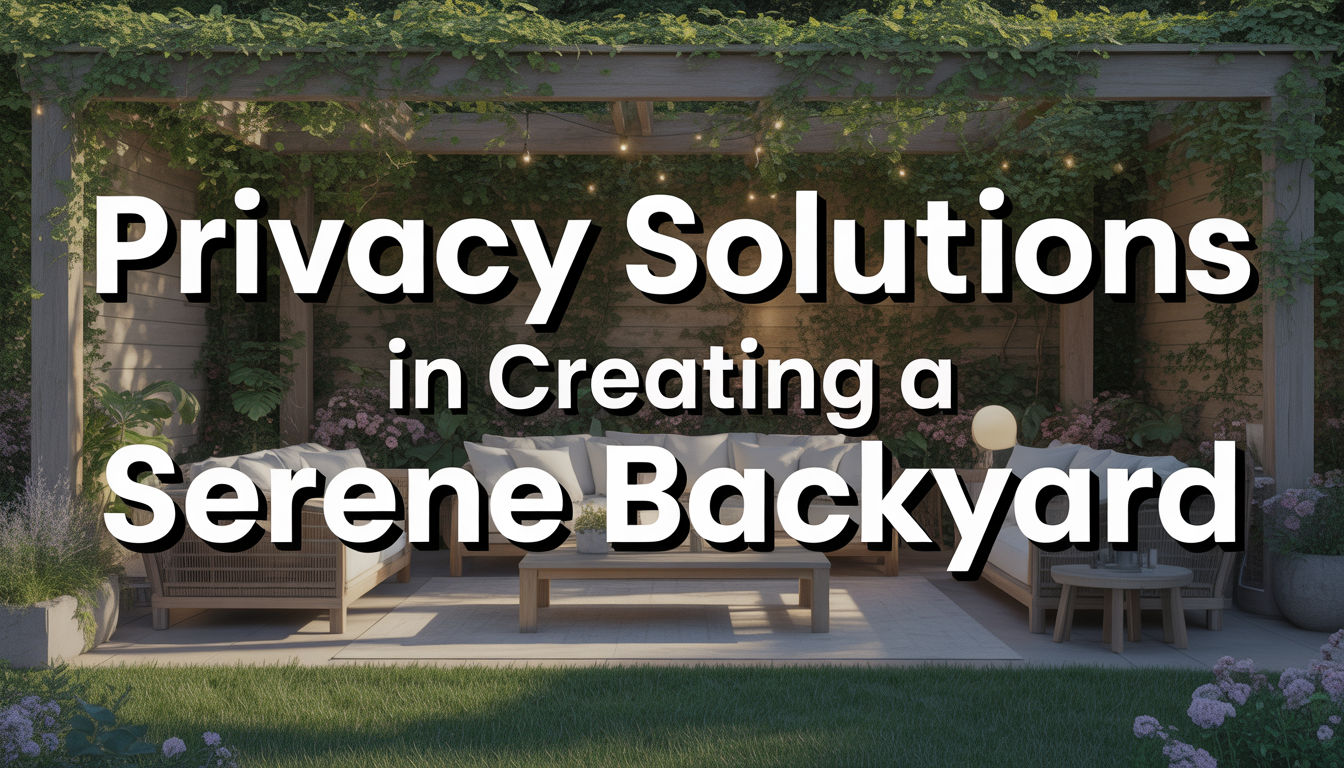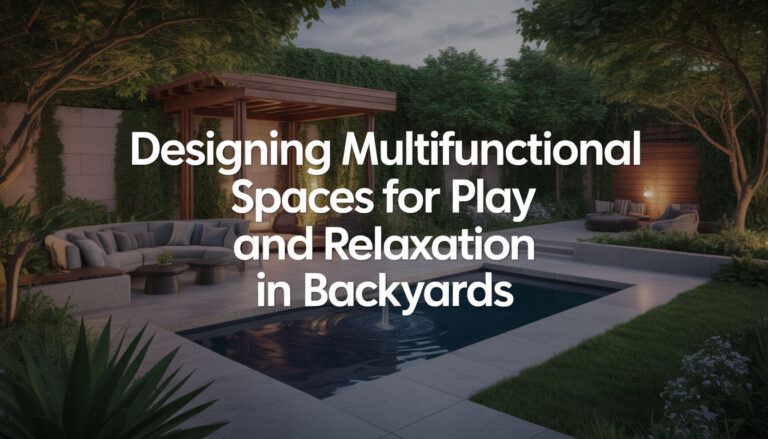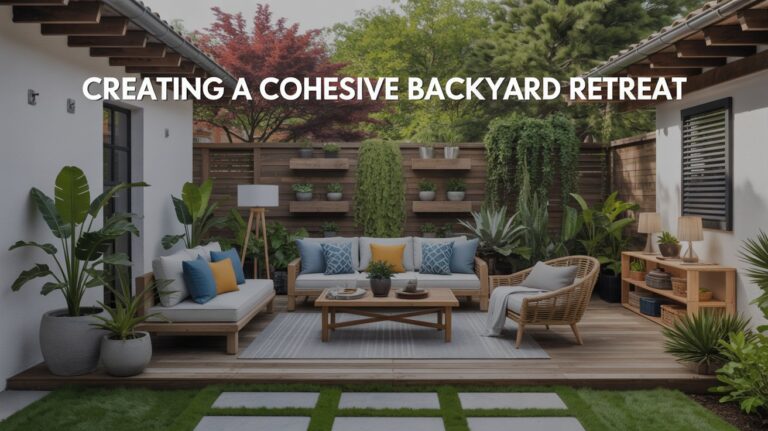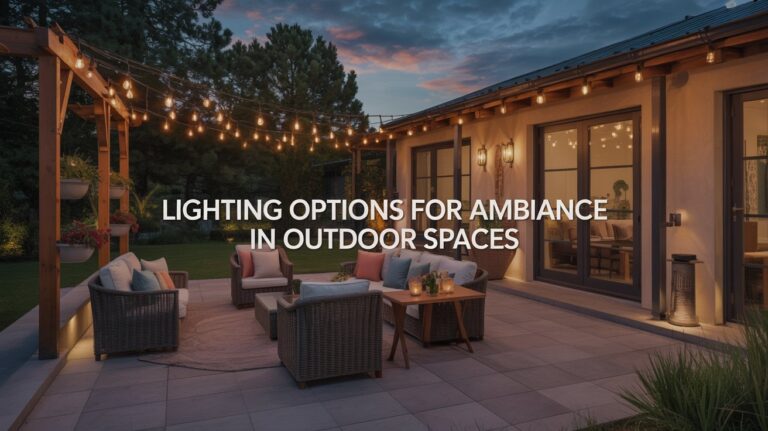The Significance of Privacy Solutions in Creating a Serene Backyard
I have been, or can be if you click on a link and make a purchase, compensated via a cash payment, gift, or something else of value for writing this post. As an Amazon Associate, I earn from qualifying purchases. Please read my full Affiliate Disclosure for more information.
Privacy solutions transform your yard into a serene sanctuary by softening sightlines, shaping mood, and inviting lingering. Start with layered screens and thoughtful plantings to mute noise and create intimate nooks. Balance enclosure with openness so you still feel connected to the surroundings. Subtle lighting guides paths and silhouettes without glare, while smart access and digital safeguards protect what matters. When these elements work in concert, your outdoor space feels calmer and more usable—and you’ll sense there’s more to uncover as you continue.
Key Takeaways
- Privacy solutions create visual and acoustic calm by blocking sightlines and reducing noise, enabling a tranquil backyard retreat.
- Layered plantings, hedges, and screens shape mood, balance openness with seclusion, and invite lingering without crowding.
- Strategic enclosure—fences and walls—frames outdoor lighting and pathways, guiding safe, serene use of space.
- Access control and subtle lighting enhance safety and comfort while preserving intimacy and unobtrusive aesthetics.
- Integrated design with seating, textures, and lighting supports predictable rhythms, reducing disturbances and promoting peaceful gatherings.
Crafting a Private Outdoor Oasis: Core Principles
Creating a private outdoor oasis starts with a clear idea of what you value most—quiet, shade, or a sense of enclosure—so you can design around those priorities. You’ll plan zones that feel intimate yet functional, choosing textures, plants, and seating that invite lingering without inviting attention. Consider privacy myths you’ve encountered and test them against your space: height alone isn’t security, and screen density isn’t mood. Use outdoor art as a focal point, not a barrier, to frame calm moments. Prioritize scalable screening, simple paths, and low maintenance features that sustain solitude while preserving openness.
The Role of Fences in Secluded Backyards
Fences aren’t just boundaries; they’re tools for shaping intimacy, light, and sightlines in a secluded backyard. You’ll choose materials and heights that balance openness with privacy, guiding how you move through space. Consider how plots of garden furniture align with paths, inviting seated moments without shouting boundaries. A fence can frame outdoor lighting, casting soft, usable glow at dusk and preserving texture in shadowed corners. Think about ventilation, airflow, and seasonal changes that influence mood. Practicality meets beauty: maintainability, durability, and acoustics matter. With intentional design, your fence becomes a quiet partner, shaping daily rituals and serene, private horizons.
Screenings and Barriers That Whisper Privacy
You’ll explore quiet privacy options that blend with your yard, using subtle screening to soften sightlines without shouting presence. Consider practical materials and textures that whisper boundaries—think layered hedges, lattices, or screens that break up lines while inviting light and air. These serene boundary solutions invite contemplation and keep your space feeling open, yet distinctly private.
Quieting Privacy Barriers
Quieting privacy barriers aren’t just about blocking sightlines; they’re about softening the boundary between public and private so you can relax in your yard. You’ll choose materials and forms that blend with your landscape, avoiding harsh lines. Think of layered screens, trellises, and planters that create gentle edges rather than fortresses. Consider wind and light, and how screenings frame views without shouting. Practical setups like compact planting, vertical gardens, or hardy shrubs offer year‑round privacy. Integrate landscape lighting to guide sightlines at evening, and place outdoor furniture to invite calm gatherings. Subtlety matters; comfort follows from thoughtful, quiet boundaries.
Subtle Screening Techniques
Subtle screening techniques blend with the landscape, offering privacy without shouting for attention. You’ll choose screening elements that echo the garden’s mood rather than overwhelm it, blending textures, heights, and seasonal color. Consider layered plantings, trellises with climbing vines, or slender evergreens that softly shield views. strategic paths and edges guide sightlines, creating intimate nooks without barriers. Landscape lighting accents silhouettes, extending usable hours while preserving-secluded feel. Outdoor furniture should invite relaxation yet stay discreet, positioned to maintain sightlines and airflow. By integrating natural materials and simple geometry, you preserve openness while safeguarding personal moments. Subtlety, not separation, defines true privacy.
Serene Boundary Solutions
As you shift from subtle screening to boundary solutions, the goal is quiet privacy that still feels part of the landscape. Serene boundary solutions blend form and function, creating barriers that soften sightlines without shouting, and they respect outdoor soundscapes rather than squelching them. Consider planting screens that mature gently, fencing with decorative panels, or trellises draped with climbers to diffuse activity beyond. Be mindful of privacy myths that promise total invisibility; true serenity lies in balanced boundaries. Choose materials and textures you’ll maintain, matching the yard’s vibe while allowing conversations to remain natural and neighbors’ awareness to stay respectful.
Strategic Plantings for Visual Calm and Seclusion
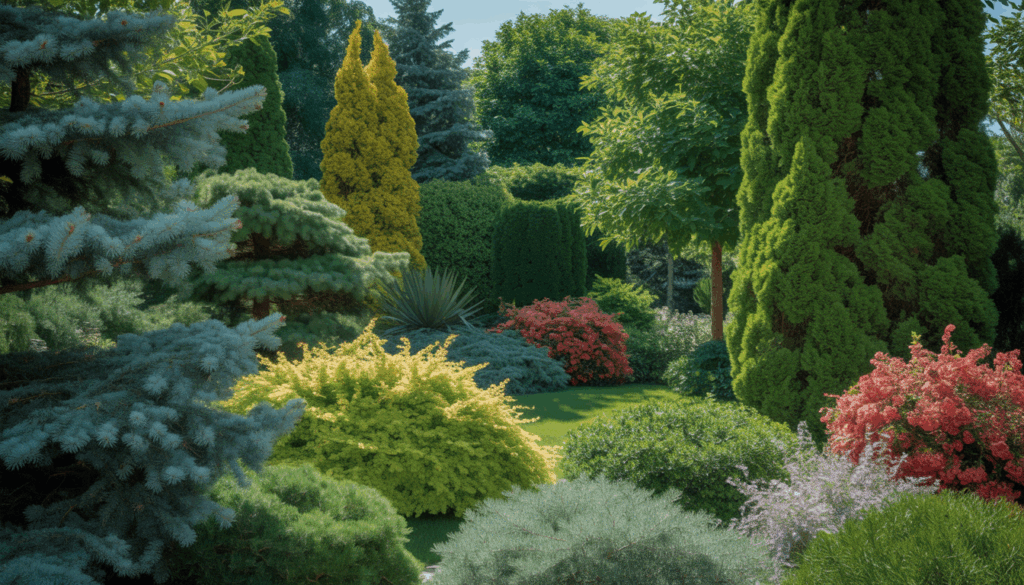
You can shape your yard with strategic planting patterns that guide the eye and reduce noise from nearby activity. Use varied heights and textures to create visual calm, while positioning taller screeners where you most want seclusion. Consider hedges and layered plantings as a flexible system you can adjust over seasons to maintain privacy and a serene feel.
Strategic Planting Patterns
Strategic planting patterns balance beauty with privacy by layering height, texture, and color to create calm sightlines and natural enclosure. You guide the garden’s rhythm by placing taller screens at edges, mid-height shrubs inward, and groundcovers as soft transitions. Consider sightline flow: align plant masses to frame views without abrupt screens, preserving openness where you want light. Use evergreens for year-round privacy and seasonal bloom for changing color. Integrate landscape lighting to subtly lift silhouettes at dusk, and choose outdoor furniture that respects scale and pace. This thoughtful arrangement supports serene, usable exterior spaces.
Visual Calm Techniques
Visual calm in plant design comes from deliberate layering and thoughtful textures that soften edges and guide the eye. You’ll balance color, form, and scale to create a quiet rhythm across borders and sightlines. Begin with medium-height foundation plants, then tuck in evergreens for year-round structure, and finally layer perennials with soft blooms to glide from focal points to ambient corners. Use landscape lighting to highlight contours without glare, and place outdoor furniture to invite pauses rather than crowd views. The result is a tranquil flow that supports privacy, invites retreat, and respects openness in equal measure.
Seclusion via Hedges
Hedges offer a reliable path to seclusion without shutting out the sky. You’ll discover that strategic plantings create calm, private space without sacrificing air or light. Consider how hedges frame your yard, guiding attention to your garden sculptures and seating area.
- Choose dense, adaptable species suited to your climate and maintenance routine
- Plant at staggered heights to balance shielding with openness
- Integrate evergreen and seasonal accents for year-round privacy
- Pair with outdoor furniture to define intimate zones
With intentional layout, you’ll enjoy quiet moments, practical use of space, and a contemplative backdrop.
Lighting That Enhances Safety Without Sacrificing Privacy
Good lighting can boost safety without peeking into every corner of your yard. You’ll want fixtures that illuminate walkways and entry points while staying discreet. Choose shaded or diffused LEDs to minimize glare and protect privacy near seating areas. Path lights, step lighting, and motion-activated sconces deter hazards without flooding neighboring yards. Consider solar options for low maintenance, but ensure they deliver steady brightness during needed hours. Place lights to highlight garden furniture and outdoor decor subtly, avoiding bright hotspots. This approach balances visibility with calm, enabling relaxed evenings and secure gatherings under thoughtfully lit skies.
Access Control: Limiting Intrusions, Maximizing Comfort
You’ll weigh privacy wall options that block sightlines without feeling fortress-like, choosing textures and heights that fit your yard. Think through access control strategies—gates, paths, and sensor ideas—that deter intrusions while keeping everyday movement smooth and welcoming. Consider comfort-driven barriers that balance security with aesthetics, so you feel protected without sacrificing your outdoor calm.
Privacy Wall Options
A privacy wall isn’t just a barrier; it’s a deliberate feature that defines how you use your yard. You’ll find that privacy wall options balance enclosure with openness, shaping mood and flow. Consider how decorative privacy screens suit your space and style, without sacrificing light or air.
- Assess privacy needs, view lines, and wind patterns.
- Compare solid, slatted, and lattice designs for texture.
- Pair materials with climate and maintenance expectations.
- Integrate planting, lighting, and seating to soften edges.
This practical approach keeps comfort intact while moderating intrusions, helping you enjoy serene moments in your outdoor room.
Access Control Strategies
Access control isn’t about locking everything away; it’s about shaping when and how people enter your outdoor space so you feel safe and relaxed. You’re curating access to minimize interruptions while preserving welcome moments. Consider smart locks for convenient entry without fumbling for keys, and set routines that adapt to your schedule. Visitor management helps you know who’s coming and when, reducing guesswork and uncertainty. Balance openness with boundaries by designating zones and clear signaling. This approach isn’t about fear; it’s about predictable rhythms that invite calm, privacy, and effortless, everyday enjoyment of your backyard sanctuary.
Comfort-Driven Barriers
To create comfort-driven barriers, think of them as soft boundaries that reduce interruptions while preserving welcoming moments. You’ll shape a calmer yard by blending function with vibe, so comfort leads, not rigid rules.
- Limit intrusions with thoughtful placement of screens and screens of privacy-perception, aligning with your outdoor decor.
- Use natural materials that feel warm and inviting, supporting a calm, private mood.
- Create retreat nooks that encourage lingering without crowding.
- Maintain visibility for safety while preserving intimate spaces, balancing openness and seclusion.
Digital Safeguards for a Private Outdoor Space
When you map out a private outdoor space, digital safeguards act as a quiet border between your sanctuary and the outside world, offering steady privacy without constant vigilance. You’ll implement clear access controls, strong passwords for devices, and regular firmware updates to minimize gaps. Practical choices matter: choose cameras with local storage and encrypted streams, and set motion alerts that only trigger meaningful activity. Prioritize privacy by limiting data retention and using digital fencing to define boundaries. Stay mindful of vendor settings, and document your policies. Smart surveillance supports peace of mind without turning your yard into a monitored exhibit.
Noise Reduction Techniques for a Tranquil Yard
Noise can quietly invade a backyard, even with strong digital safeguards in place, so practical noise-reduction strategies deserve a focused look now. You’ll find it’s about purposefully shaping sound, not silencing life.
- Assess sources and distances to choose targeted solutions.
- Use soundproofing materials where rooms meet outdoors and around patios.
- Install outdoor acoustic panels to reflect or absorb noisy impulses.
- Layer barriers like fences, vegetation, and mulch to disrupt low, mid, and high frequencies.
Implementing these steps creates calmer evenings, clearer conversations, and a more serene outdoor retreat.
Design Tricks to Create Perceived Privacy
Small design moves can make a big difference: you don’t need solid walls to feel shielded, just deliberate layout and textures that cue privacy. You can stage sight lines with plant screens, layered fencing, or raised beds that break exposure without enclosing you. Use patio furniture orientation and shade structures to create intimate pockets, guiding how you move and pause. Consider textures, colors, and vertical elements that whisper privacy rather than shout it. Be mindful of privacy myths—you don’t need total enclosure. In urban privacy, attention to scale, rhythm, and restraint makes a calm, protected feeling with daylight still flowing.
Maintaining Balance: Privacy and Open-Air Enjoyment
Balancing privacy with open-air enjoyment isn’t about choosing one over the other; it’s about arranging both so you can savor solitude and social moments alike. You’ll find balance by aligning design with daily use, so every activity feels natural.
- Focus on scale and placement to protect privacy without blocking light
- Combine screens with greenery to enhance outdoor aesthetics
- Schedule moments of seclusion between social gatherings
- Question privacy myths that urge total seclusion or constant visibility
Use calm materials, test sightlines, and adapt as seasons shift for true serenity in your yard.
Conclusion
You’ve learned that privacy isn’t just walls and hedges—it’s a deliberate rhythm of space, light, and sound. With practical steps, you can carve a serene backyard that feels protected yet open to nature. Start small: a screening you barely notice, a plant you nurture, a path you trust. Let each choice calm you, not confine you. Privacy grows as you tune the balance between safety, sociability, and quiet, turning your outdoor hours into a mindful retreat.
